Throughout the span of his career as a Chicago-based designer, art director, and entrepreneur Emmett McBain designed for companies and products that in many ways defined the standard of sixties cool: Playboy Records, albums covers, ad campaigns for cigarettes, and the launch of the 1964 Ford Mustang. After graduating from the American Academy of Art, he joined Vince Cullers Advertising, the first African-American-owned ad agency, in 1956. He launched his own agency, McBain Associates, in 1959, and after returning to Vince Cullers in 1968 as art director, would go on to co-found Burrell McBain, Inc., with fellow black designer Tom Burrell in 1971.

“Black is Beautiful,” c. 1968: Ad for Vince Cullers Advertising, Inc., creative direction by Emmett McBain. All images courtesy of the University of Illinois at Chicago, Richard J. Daley Library, Special Collections and University Archives.
His resumé alone could give any aspiring designer career envy. However what made him a provocateur—what made him important to history beyond design—was his assertion through ads to the general public that “black is beautiful.” This assertion would set the tone of his work for the rest of his career. According to his long-time friend Ben Counts (founder and creative director of Chicago-based agency Creative for Good), it was that kind of assertion that made his work ascend to become “just as much art as it was advertising.”
And so it seems fitting that when I asked McGhee Osse, who knew McBain well and is co-CEO of Burrell Communications Group, which social issue McBain’s work could impact most, she said “social equity.”
“He was very much an enthusiast and advocate for the African-American community and culture,” Osse said of McBain. “Much of his work uplifted the community by reflecting the true identity of a people—whether on canvas or in national ads. His work was characterized by a freedom that lived boldly in his heart and which he wished upon all people of color and on humanity as a whole.”
Osse was not alone in recognizing this theme throughout McBain’s work. For Counts, McBain’s projects brought to mind “the concept of positive realism”—that “you can show people who are different than white people and yet have something kind of inherently noble about the lives that they create for themselves.”

True Advertisement, 1968: Ad for Lorillard Tobacco Company’s True menthol cigarettes, Vince Culler Advertising, whose work for the Lorillard Tobacco Company laid the groundwork for how cigarette companies and other businesses spoke to Black consumers.
To the consuming public, the concept of “true identity” can be something that is difficult to parse when taking in an ad that is aiming to sell you a product—to convince you what you should buy, or wear, or look like; that is inherently telling you to be different than you currently are. An idea like beauty, wealth, or happiness, presented as “truth” can feel like a manipulation. And so it must have been a revelation to look onto the page of a magazine and not be told to buy a product in order to look like someone else, but to continue to look like you. “The mission depicting black people in advertising—they weren’t… actors, they were just people… it was amazing the kind of impact it had on the public, ” said Tom Burrell of the Burrell McBain body of work while being interviewed for McBain’s AIGA Medalist video.
“Our work went on network television. What we were saying to black people, we were saying in the presence of a white audience. That’s what made a difference,” Burrell continued. With that statement made to the public at large, McBain set the tone for what Counts called “black-targeted advertizing,” with the ideal to attain being yourself, just as you are.

SkinFood Cosmetics: Sketch created by Emmett McBain. In the late 1960s and early 1970s, beauty products were created specifically for African Americans and given shelf space in major department stores for the first time.
McBain left Burrell McBain in 1974 to pursue an art career, with a desire to uplift the community in a more direct way. “He was not afraid to point out things that he saw,” said Burrell of his business partner. And McBain didn’t shy away from using his craft as a tool for public good either. In fact, it seems that as his career progressed, that become more and more of an imperative to him.
According to the University of Chicago Library, after leaving Burrell McBain, McBain offered his design services to “non-commercial projects, from a journal of African diaspora thought to a local organization supporting the re-integration of former inmates into Chicago's southside community.”
The freedoms that McBain conveyed through his work and that he desired for others seemed to ensure a trajectory that would veer from advertising. “This freedom negated biases, prejudices, phobias, and all the isms that existed during his time and still live today,” Osse said of the philosophy that made McBain who he was.

“Creative Juices,” 1974: Front and back of an invitation to the exhibition for McBain’s arts consultancy The Black Eye. The invitation gives the founding date of The Black Eye as 1935, the year he was born.
We know that advertising isn’t just about selling a product. It’s about selling an idea; a way of life that is associated with the product being submitted to you. As part of a campaign for Beefeater Gin, McBain’s team at Eisaman, Johns & Laws wrote alongside the image of a tree with far-reaching roots that “Most of what we’re made of lies beneath the surface. But, if you have a strong sense of your roots, people will come to see that you really stand for something.”
That sounds like some damn good gin, but not because we know anything about the taste—because the copy McBain and his team wrote added gravitas to the experience. Yes, this copy was for an advertisement. But you can’t help but find parallels to McBain himself. His personal philosophies were a constant presence in his work—it was that interaction between his personal experience and his professional projects that was his trademark. And so, with a strong sense of his roots, the fact that he stood for something came across every page he produced.
Like “truth,” the concept of “art,” equally evades definition. What makes it so? A technical or visual expertise used in an aim for enlightenment? To appeal to our emotions? Art, produced with our left, creative brain, and divorced from linear concepts of logic, is both a reaction to the time in which it was made and an aim to make us question the beliefs that we’ve inherited. It’s difficult to determine when exactly McBain stopped being an art director and started being an artist. Some might say that art is what you make it. McBain ensured that it made a difference.
